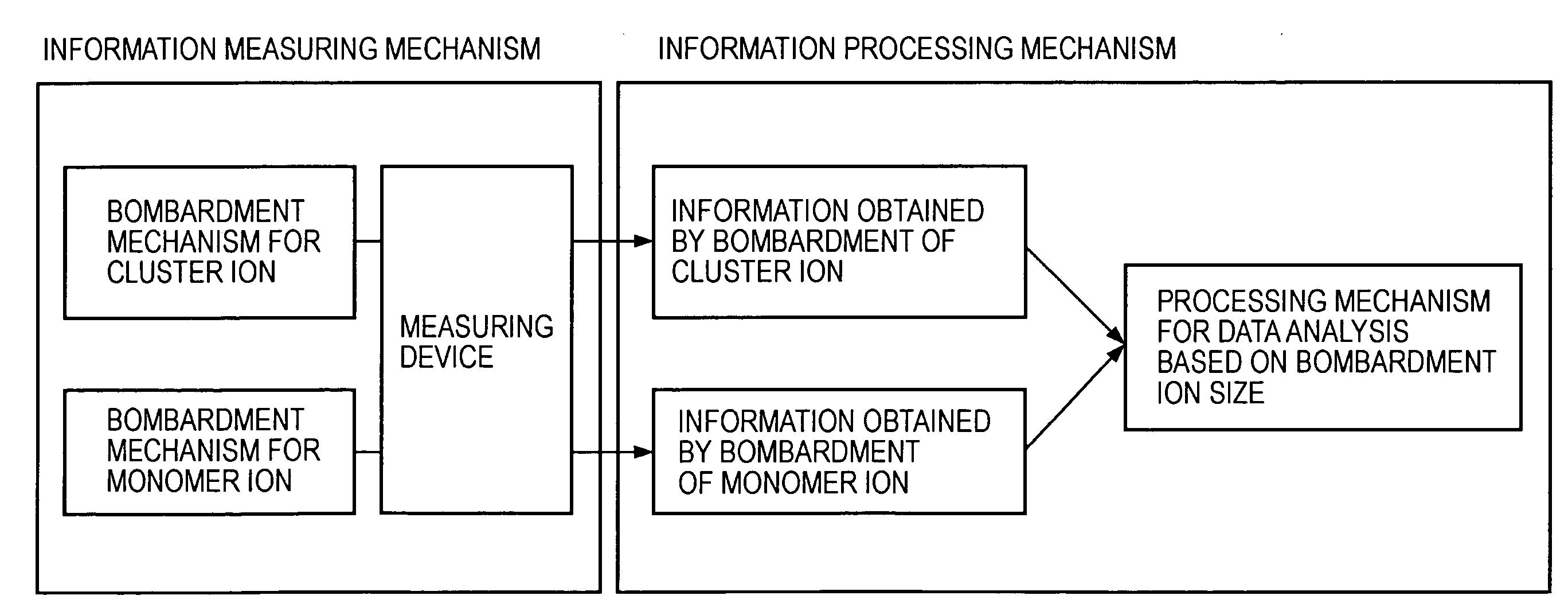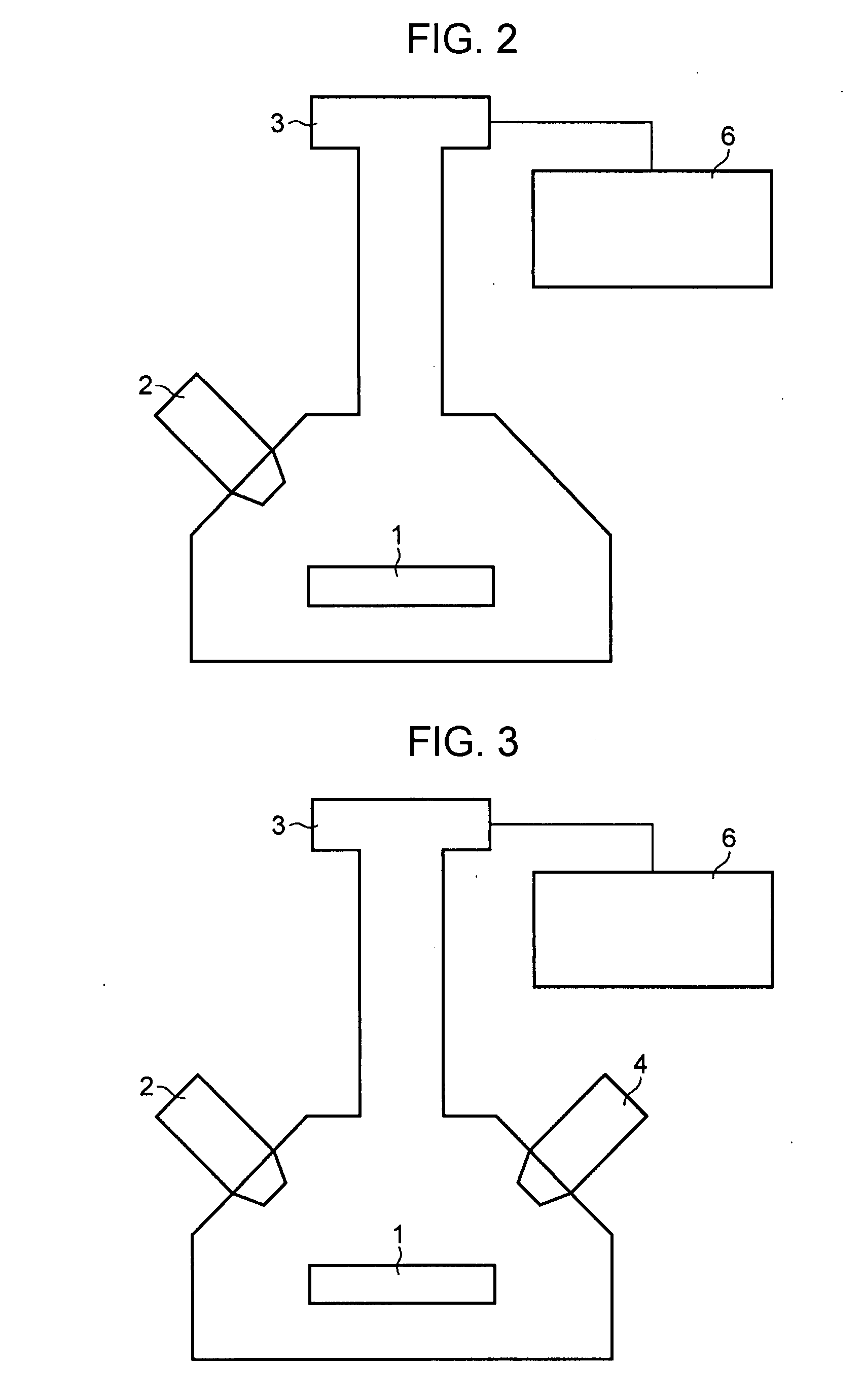Surface analysis apparatus and method using ion bombardment
a surface analysis and surface technology, applied in chemical methods analysis, separation processes, instruments, etc., can solve the problems of inability to determine the precise analysis depth point in the surface, difficult analysis, and inability to analyze the depth of the primary ions. to achieve the effect of minimizing the contamination of the sputtered surfa
- Summary
- Abstract
- Description
- Claims
- Application Information
AI Technical Summary
Benefits of technology
Problems solved by technology
Method used
Image
Examples
first embodiment
[0046]FIG. 1 is a block diagram showing the configuration of a surface measuring apparatus according to a first embodiment of the present invention. The surface measuring apparatus shown in FIG. 1 includes an information measuring mechanism for measuring a sample, and an information processing mechanism for analyzing the obtained results.
[0047]FIG. 2 is a schematic drawing of a time-of-flight secondary ion mass spectrometer corresponding to the information measuring mechanism of the surface measuring apparatus shown in FIG. 1.
[0048]The time-of-flight secondary ion mass spectrometer shown in FIG. 2 is provided with an ion bombardment mechanism 2. The ion bombardment mechanism 2 includes a monomer ion bombardment function to bombard monomer ions and measure a mass spectrum of secondary ions, and a cluster ion bombardment function to bombard cluster ions and measure a mass spectrum of secondary ions.
[0049]The monomer ion bombardment function may include bombardment of monomers of at le...
second embodiment
[0063]FIG. 3 shows an apparatus for structural analysis in a depth direction by fullerene ion sputtering according to a second embodiment of the present invention.
[0064]In addition to the constitution shown in FIG. 2, the apparatus for structural analysis in the depth direction by fullerene ion sputtering shown in FIG. 3 is provided with a fullerene ion sputtering mechanism 4 capable of sputtering fullerene ions as sputtered ions. Namely, the apparatus is provided with both the ion sputtering mechanism 4 capable of sputtering fullerene ions and the ion bombardment mechanism 2 capable of bombarding with primary ions.
[0065]Like in FIG. 1, in FIG. 3, an ion bombardment mechanism capable of bombarding with cluster ions of gold or bismuth as primary ions, and an ion bombardment mechanism capable of bombarding with monomer ions of gold, bismuth, gallium, indium, or germanium are provided or changed from one to the other to provide the mechanism 2 capable of bombarding a surface of a test ...
third embodiment
[0077]In the present invention, a sample 1 can be sputtered with fullerene ions while being cooled to analyze a structure in the depth direction.
[0078]FIG. 5 is a schematic drawing showing a time-of-flight secondary ion mass spectrometer provided with a cooling mechanism according to a third embodiment of the present invention.
[0079]In addition to the constitution shown in FIG. 3, the apparatus shown in FIG. 5 is provided with a mechanism 5 for cooling a measurement sample with liquid nitrogen. Since the other components are the same as in FIG. 3, the components are denoted by the same reference numerals.
[0080]The cooling mechanism 5 is adapted for cooling a measurement sample 1 by heat conduction from liquid nitrogen. The cooling temperature is preferably −100° C. or less, and the cooling atmosphere is preferably a vacuum atmosphere or an atmosphere at a low moisture pressure. When the cooling temperature is −100° C. or more, some liquid components or volatile components to be meas...
PUM
 Login to View More
Login to View More Abstract
Description
Claims
Application Information
 Login to View More
Login to View More - R&D
- Intellectual Property
- Life Sciences
- Materials
- Tech Scout
- Unparalleled Data Quality
- Higher Quality Content
- 60% Fewer Hallucinations
Browse by: Latest US Patents, China's latest patents, Technical Efficacy Thesaurus, Application Domain, Technology Topic, Popular Technical Reports.
© 2025 PatSnap. All rights reserved.Legal|Privacy policy|Modern Slavery Act Transparency Statement|Sitemap|About US| Contact US: help@patsnap.com



